Plan checklist
Mississauga Lake Rental 1
, Mississauga Lake
Planting plan created by The Land Between charity
Schedule A:
Plants & Property
Land Characteristics
This planting plan is designed based on the land characteristics identified during the day of the site visit. Plants are chosen according to the soil and light conditions on your property. The number of plants chosen for each planting compartment takes into account the square metre area of the space, as well as the amount of current vegetation cover. Your property is part of ecoZone: 5b
Land Characteristics by Compartment
| Length | Width | Area | pH | Soil | Moisture | Light | Height | |
|---|---|---|---|---|---|---|---|---|
| A | 0m | 0m | 0m2 | basic | sandy | normal | partial sun | any |
| B | 0m | 0m | 0m2 | normal | loamy | normal | partial sun, shade | any |
| C | 0m | 0m | 0m2 | normal | loamy | normal | partial sun | |
| 0m | 0m | 0m2 |
Plant Selection Summary
The following shrubs and trees are chosen for their suitability and survivability given the current soil and light conditions in each compartment on your property, as well as preferable features.
| Plant Species | A | B | C | Potted | Bareroot | Wildflower |
|---|---|---|---|---|---|---|
| Bebb Willow | 2 | 2 | ||||
| Narrow Leaved Meadowsweet | 8 | 8 | ||||
| Bearberry | 18 | 8 | 26 | |||
| Smooth Wild Rose | 6 | 6 | ||||
| Alternate-Leaved Dogwood | 2 | 2 | 4 | |||
| Shrubby Cinquefoil | 10 | 10 | ||||
| Virginia Creeper | 2 | 4 | 2 | 4 | ||
| Ninebark | 3 | 4 | 7 | |||
| Black Chokeberry | 2 | 2 | ||||
| Wild Geranium | 24 | 24 | ||||
| Bunchberry | 8 | 11 | 19 | |||
| Green-Headed Coneflower | 8 | 8 | ||||
| Common Evening Primrose | 6 | 6 | ||||
| Subtotal | 10 | 83 | 35 | 67 | 0 | 61 |
| Totals | 128 | |||||
Plant Information
The following table summarizes key information about each plant selected for your property.
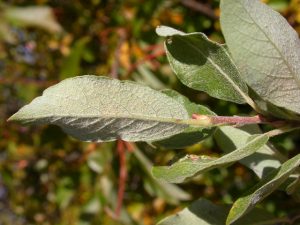
|
Bebb WillowHeight: 5 m
The Bebb Willow is a mid-sized deciduous shrub species that can grow up to 5 m in height. This plant may also be known by the common names Beaked Willow and Diamond Willow. The leaves are alternately arranged, dull green in colour, have wrinkled and hairy undersides, are narrow and elliptic in shape (but broad for willow), and have toothed margins. The bark is reddish or grayish-brown in colour and may have diamond-shaped patches along the main stems. The catkins are light green or yellow coloured and appear with the leaves between May and June. The roots can useful for controlling erosion and stabilizing shorelines.
|
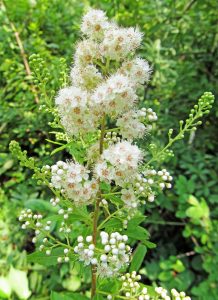
|
Narrow Leaved MeadowsweetHeight: 1-2m
The Narrow Leaved Meadowsweet is an erect, deciduous shrub, which grows in the shape of a mound to a height of 1-2m. This species develops numerous branches and branchlets, giving it a sparse appearance. Leaves produced are simple and narrow with sharply toothed borders growing alternately along the branches. These bright, light green leaves appear crowded, as they grow close together on the stocks and branches. During the fall, leaves turn a yellow-red or yellow-orange colour. Small white to light pink flower clusters appear in the spring growing in a dense, narrow pyramid at the terminal ends of the branches. During late summer to early fall, these flowers produce smooth, papery seed pods.
|
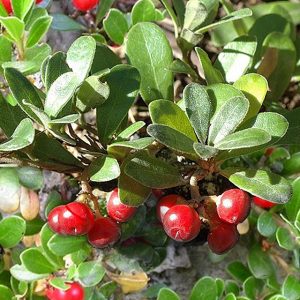
|
BearberryHeight: 20 cm
Bearberry is a low growing, evergreen shrub/ground cover species that grows about 20 cm tall. The leaves are dark green, leathery, shiny, ovate shaped, alternately arranged, and have entire margins. The flowers are tiny, urn shaped, white to pink colored, appear in drooping clusters, and bloom between April and May. Flowers are followed by bright red berries, which remain throughout the fall and winter. These berries are beneficial to wildlife species like birds and small mammals.
|
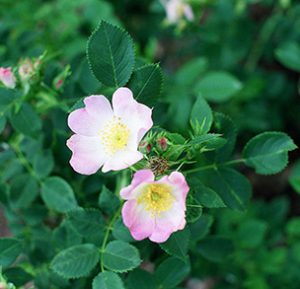
|
Smooth Wild RoseHeight: 1.5m
The Smooth Wild Rose is a shrub species that grows about 1.5 m tall. The name is derived from the fact that it is almost thornless with only a few sharp thorns present near its base. This native shrub is best known for producing beautiful pale pink flowers with five saucer-like petals surrounding a yellow center. The Smooth Wild Rose produces bright red rose hip fruiting bodies which develop during the summer and persist throughout the winter. Leaves produced are alternate and compound, consisting of 5-7 serrated, egg-shaped leaflets.
|
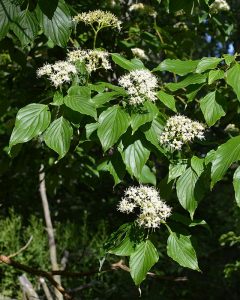
|
Alternate-Leaved DogwoodHeight: 5-10 m
The Alternate-Leaved Dogwood is a tall, deciduous shrub or small tree species that can grow 5-10 m in height. This plant may also be known by the common name Pagoda Dogwood. It can be grown either in the form of a single stem tree or multi-stemmed shrub comprised of two or three smaller trunks. The leaves are ovate shaped, alternately arranged, have prominent veins, have a pointed tip, and have entire margins. The flowers are showy, fragrant, whitish yellow, appear in flat clusters, and bloom between May and June. These flowers produce clusters of dark blue berries. The flowers are beneficial for pollinator species while the berries are beneficial for wildlife species. The root system is valuable for controlling erosion and stabilizing loose soil. This plant is often used as a small ornamental tree in landscaping. The common name comes from the fact that all other Dogwood species have oppositely arranged leaves.
|
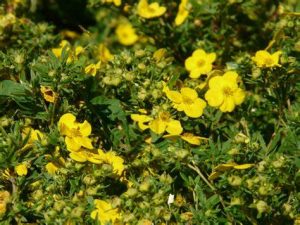
|
Shrubby CinquefoilHeight: 1 m
Shrubby Cinquefoil is a hardy, deciduous shrub species that grows about 1 m in height. The stems are reddish brown to gray and appear shredded with age. The leaves are green to blueish green, narrow and elliptic shaped, hairy, alternately arranged, compound with 5 leaflets, and have entire margins. The flowers are showy, yellow, saucer shaped, have five petals, appear in small clusters on terminal branches, and bloom between June and September. In the fall, the flowers give way to an oval-shaped, brown fruit covered in white hairs. The flowers are beneficial to pollinator species, like bees and butterflies. This is a popular shrub for ornamental use in gardens.
|
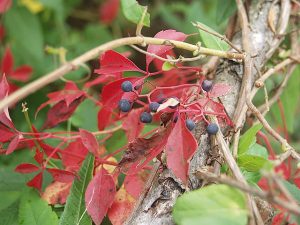
|
Virginia CreeperHeight: 15 m
The Virginia Creeper is a deciduous, woody vine species which can grow up to 15 m if near a tall structure or tree. The leaves are palmately compound with five ovate shaped leaflets. These leaves are largely toothed and turn bright red and orange during the fall. Despite having inconspicuous flowers, this species produces incredible dark blue berries, which are beneficial to birds and small mammals. This vine can grow 2-3 m per growing season, thus pruning and maintenance may be required. Virginia Creeper may sometimes be confused with Poison Ivy as younger plants will only have three leaflets instead of five. This plant can grow aggressively so should be planted where it has plenty of space to spread. Some shoreline landowners choose to plant this around rip rap/loose stone retaining walls for a more natural appearance. The root system is beneficial for quickly controlling erosion.
|
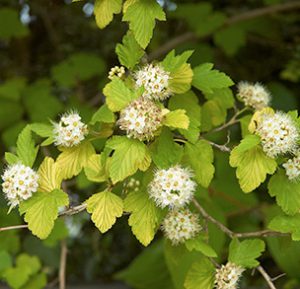
|
NinebarkHeight: 2-3m
The Common Ninebark is a very hardy, large (2-3m in height), deciduous shrub naturally occurring within riparian zones. This species is often planted as an ornamental shrub for its exfoliating bark which reveals reddish-light brown inner bark. This shrub is multi-stemmed with numerous horizontal and ascending branches creating a full, round shape. The Common Ninebark produces dull green, ovate to round shaped leaves with three to five lobes per leaf. During the fall the leaves turn brilliant yellow or dark purple. Between May and June, showy, bell-shaped flowers bloom in clusters on the terminal ends of the branches. During the summer, these flowers give way to small green or green-yellow berries which turn a bright red upon ripening.
|
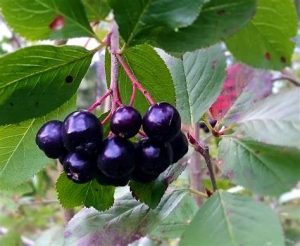
|
Black ChokeberryHeight: 1-3m
The Black Chokeberry is a medium sized deciduous shrub that typically grows between 1-3m with edible fruit. This species requires full sun to partial shade and can tolerate soil conditions from loamy and moist to rocky and dry. Naturally, Black Chokeberry is found in wet wooded areas such as; swamps, along shorelines, and within forest understory. This species is multi-stemmed, and forms thickets from stems which arise from the roots. Leaves are simple, growing alternately along the branch turning a bold red to orange during the fall. During spring, clusters of showy, white flowers appear turning into dark purple berries by fall. This species is resistant to drought, insects, pollution, and disease. The Black Chokeberry is often cultivated as an ornamental plant and food product. Additionally, this species is useful for bank stabilization and erosion control applications.
|
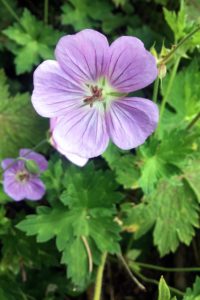
|
Wild GeraniumHeight: 70 cm
Wild Geranium is a herbaceous perennial wildflower species that grows up to 70 cm tall. The leaves on the wildflower are basal with 5-7 deeply divided toothed lobes, ranging between 10-13 cm wide. Due to the shape of the leaves, Wild Geranium is often mistaken for Canada Anemone. It is often found in meadows and forests, preferring partial to full shade with moist loamy soil. Wild Geranium is an ideal wildflower for erosion control because it forms colonies through it's rhizome system. The small petaled purple flowers attract a variety of bees and butterflies, making it a great addition to your garden for pollinators. Wild Geranium has also been used for many medicinal purposes due to its astringent properties. The rhizomes are dried and grounded to be used for mouth ulcers, inflamed gums, and sore throats.
|
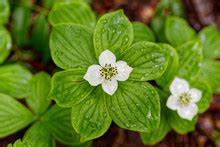
|
BunchberryHeight: 15 cm
Bunchberry is a deciduous ground cover species that can grow around 15 cm in height. This plant may also be known by the common name Creeping-Dogwood. The leaves are deep green, oppositely arranged, oval shaped, and glossy. The flowers are showy, white colored, and bloom between May and June. These flowers produce bright red berries that are edible to humans and beneficial to wildlife species, like birds and small mammals.
|
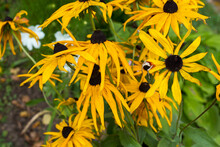
|
Green-Headed ConeflowerHeight: 2.5m
Green-Headed Coneflower is a perennial wildflower that grows from 1-2.5 m in height. The stem is light green, smooth, cylindrical, and branches occasionally. The leaves alternate along the stem and can grow up to 30 cm long and 30 cm wide. The leaf stems are narrow, which gives the leaves a tendency to droop. The lower to middle leaves have 3-7 large lobes and smooth to highly toothed edges. The leaves tend to change in shape depending on how large they grow; but are usually elliptic to ovate in shape. The uppermost leaves on the flowering stalks are much smaller in size and lanceolate to ovate in shape without lobes. The upper leaf surface is dark green and hairless while the lower leaf surface is pale-medium green and sparingly hairy. The stems terminate with clusters of yellow flowers that each have their own stalk up to 5 cm in length. The flowers are 5-8 cm across and have a round center with 6 to 12 yellow petals. The central cone is light green while immature, but it later changes to a yellow colour, resembling a pincushion because of its tubular disk florets that all come out of the cone. Each disk floret is replaced by a 3-4.5 mm, hard, oblong shaped seed pod that has a crown of tiny blunt teeth at its apex. Green-Headed Coneflower prefers moist soils and partial sun. It can be found growing naturally in wet open forests, moist meadows, forest edges, moist thickets, river banks, lake shorelines, and pastures. This wildflower is tolerant of slow-draining, clay-heavy soils. The root system is fibrous and forms clusters that spread through underground rhizomes, which makes this plant great for erosion control, as it will spread and stabilize the soil. Many pollinators are attracted to the Green-Headed Coneflower including bees, wasps, butterflies, skippers, moths, and various kinds of flies. Several insects and animals use the plant for food, including Golden Glow Aphids, Silvery Checkerspot Butterflies, Tortricid Moths, Wavy-Lined Emerald Moth, and Common Pug Moth. Additionally, some bird species like Common Goldfinches feed on the seeds of Green-Headed Coneflower.
|
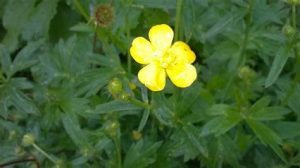
|
Common Evening PrimroseHeight: 1 m
Common Evening Primrose is a biennial herbaceous wildflower species that typically grows about 1 m in height. The first year, the plant appears as a rosette of basal leaves, then grows a stiff, hairy, flowering stem the second year. The leaves are light or olive green colored, narrow, lance shaped with a pointed tip, and have toothed margins. The flowers are bright yellow, fragrant, bowl shaped, have four petals, and bloom between June and September. The flowers open up at a visibly fast speed in the evening (giving the flower its name) and remain open from evening to early morning, but may remain open longer on cloudy days. Long narrow seedpods develop, which split open from the top to release many tiny, irregular brown seeds. The seeds are small enough to be dispersed by the wind. The root system consists of a fleshy taproot. The taproot and shoots are both edible. This wildflower attracts pollinator species such as Sphinx Moths, Ruby-Throated Hummingbirds, Honeybees, and Bumblebees.
|
Compartment A
Naturalization Area
 pH: basic
pH: basic Depth: potted, wildflowers
Depth: potted, wildflowers-
 Moisture: normal
Moisture: normal -
 Soil Type: sandy
Soil Type: sandy  Plant Height: any
Plant Height: any-
 Light conditions: partial sun
Light conditions: partial sun
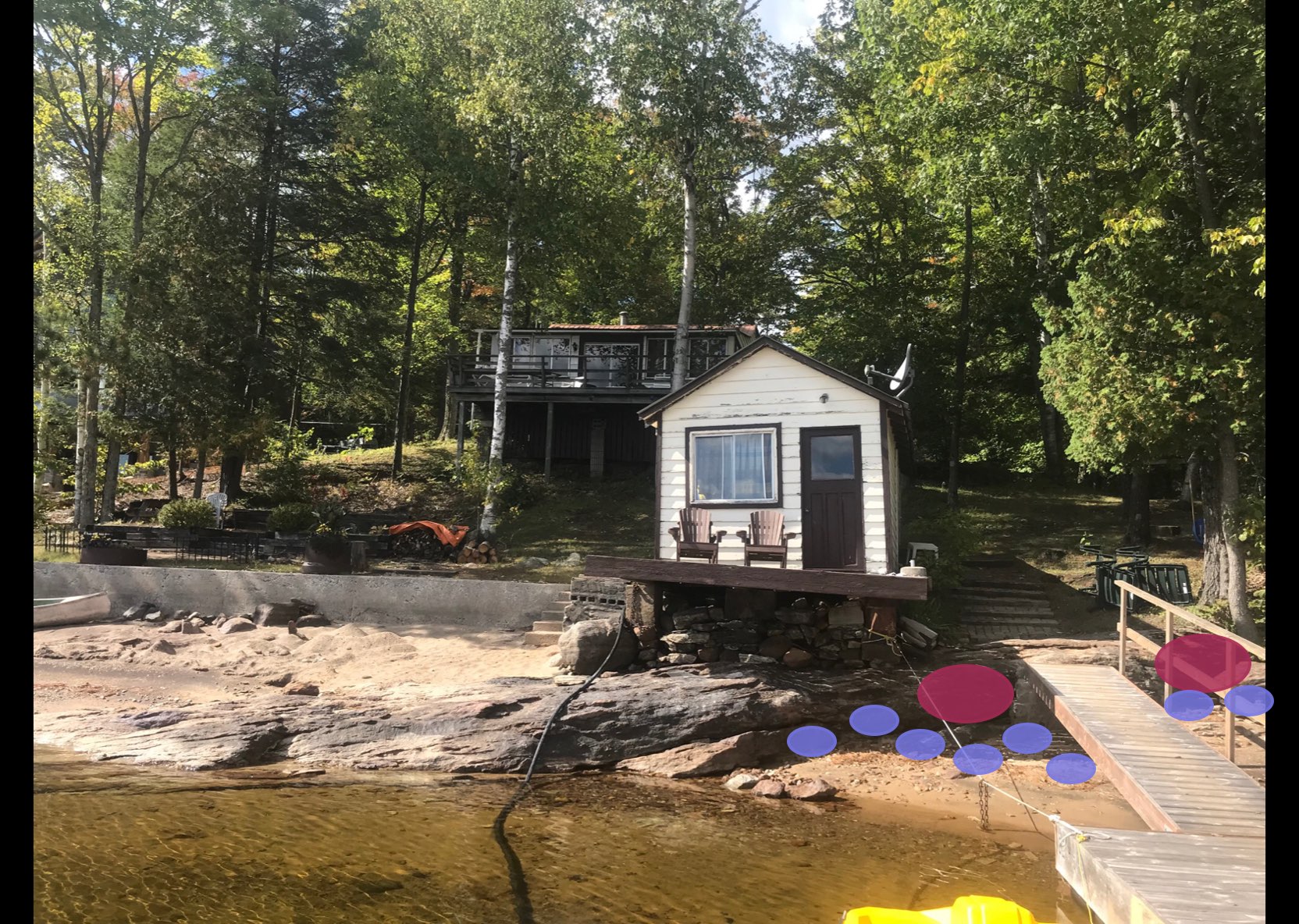
Compartment B
Naturalization Area
Increase biodiversity and beauty by the cottage pH: normal
pH: normal-
 Moisture: normal
Moisture: normal -
 Soil Type: loamy
Soil Type: loamy  Plant Height: any
Plant Height: any-
 Light conditions: partial sun, shade
Light conditions: partial sun, shade
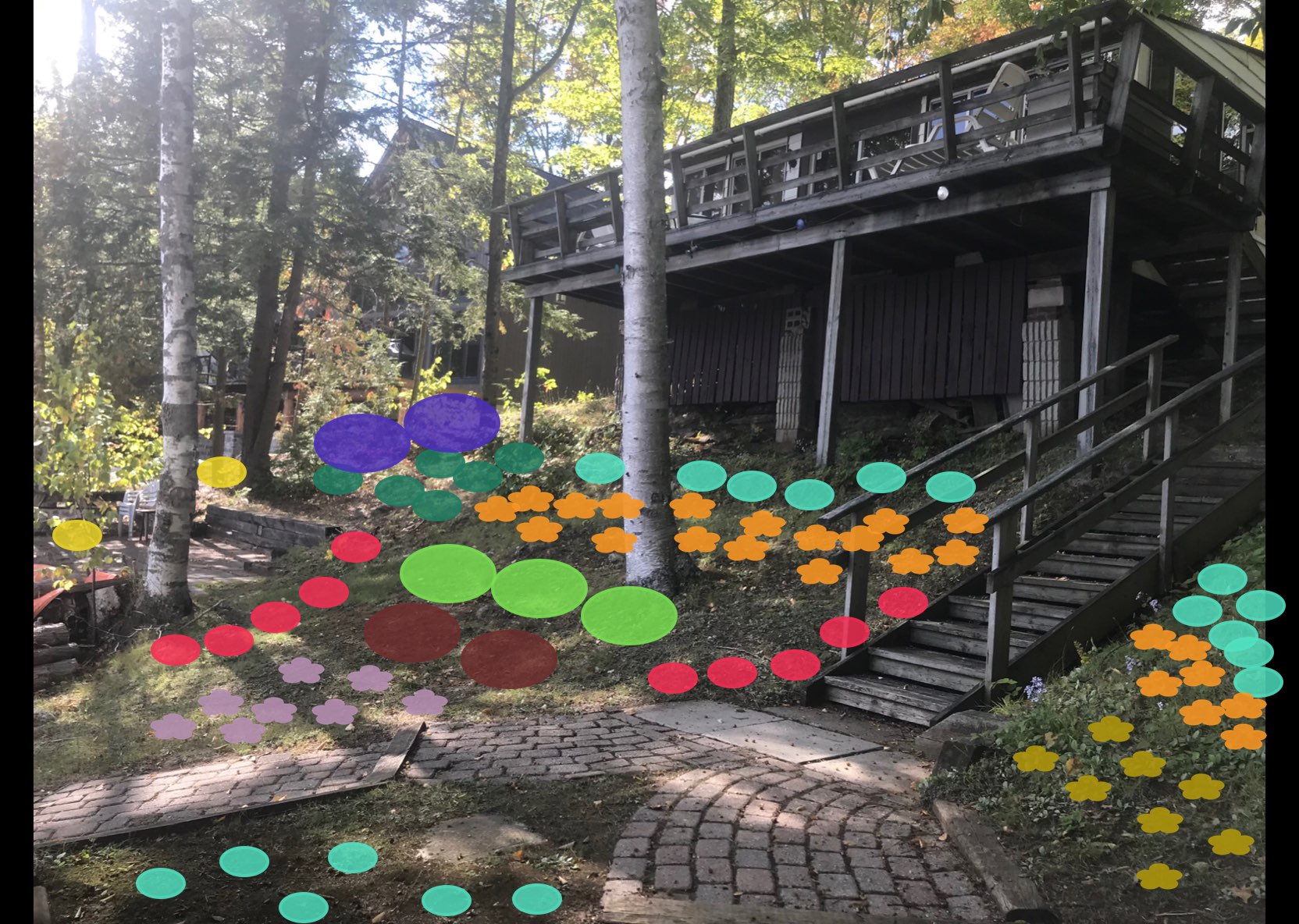
Compartment C
Naturalization Area
Maintain views. Add beauty. Increase biodiversity pH: normal
pH: normal Depth: wildflowers
Depth: wildflowers-
 Moisture: normal
Moisture: normal -
 Soil Type: loamy
Soil Type: loamy -
 Light conditions: partial sun
Light conditions: partial sun
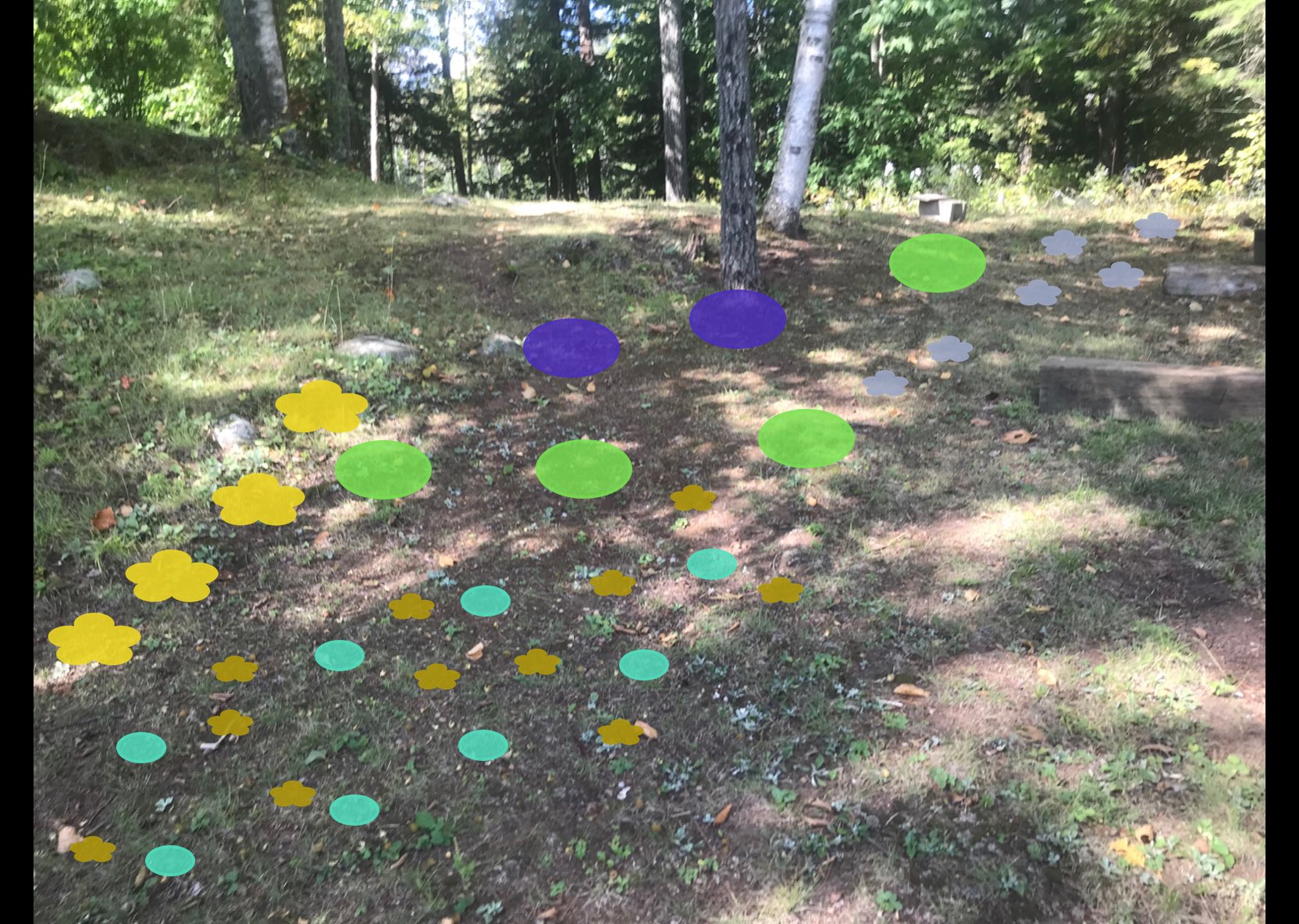
Schedule B
Financial Summary
Project by: The Land Between charity
Shoreline Re-Naturalization Starter Kit includes: free site visit, customized re-naturalization planting plan for your shoreline property, native plants including free bare root (small) and potted (large) plants and wildflowers, coconut fibre pads to deter grass from growing around new plantings, tree guards for all deciduous trees, mulch for your wildflowers, Plant Care Guide with instructions on how to take care of your new plants, Habitat Creation Guide and a Wildflower Garden Guide.
Our planting plans are created onsite with you and provide detailed information and plans to re-naturalize your shoreline property. We take photos of areas for planting and overlay native plants that are well suited to your property based on site conditions such as soil type and sunlight availability.
We will work with you to create a plan that works for you including options for low growing plants in areas where views are important.
| Item | Quantity | Cost/Item | Subtotal |
|---|---|---|---|
| Starter Kit fee | $250 | ||
| Free potted plants | 8 | $0 | $0 |
| Paid potted plants | 59 | 13.00 | 767.00 |
| Free bareroot plants | 0 | $0 | $0 |
| Free wildflowers | 10 | $0 | $0 |
| Paid wildflowers | 51 | 10.00 | 510.00 |
| Total costs | 1527.00 |
Schedule C
Project Agreement
Stewardship Agreement
Please indicate your agreement to this proposed plan by signing the following Stewardship Agreement and submitting it, along with your financial contribution, to:
The Land Between charity
Box 1368, 6712 Gelert Road,
Plant Availability
Please note that plant species may need to be changed based on plant stock availability at the time of ordering.
Project Completion
Upon receiving your signed stewardship agreement and financial contribution, a date will be booked for you to pick up your Natural Edge Kit. The Land Between charity will supply all plants and materials. If you are paying for the planting to be completed for you, a date will be arranged for The Land Between charity to plant your shoreline, bringing the plants and materials with them. If there are particular dates that you would prefer, we will do our best to accommodate your requests.
The Natural Edge Stewardship Agreement with The Land Between charity
Agreement made this Day of the Month of in the Year .
BETWEEN Carla S Neighbour (Hereinafter called the OWNERS)
AND The Land Between charity Box 1368, 6712 Gelert Road, (Hereinafter called TLB)
WHEREAS the Owners and TLB have met and discussed plans for shoreline naturalization on the specified area(s) in Schedule A existing on the Owners’ land;
WHEREAS the Owners indicate approval of the project as proposed; and
WHEREAS the project is, or will be for the benefit of the Owners and others;
NOW THEREFORE THE PARTIES AGREE AS FOLLOWS:
1. This Agreement shall be in effect for a period of 5 years, commencing with the date of this Agreement.
2. The Owners and TLB agree that the areas where the work is to be performed is as described in Schedule A.
3. The Owners agree to pick up their Natural Edge Starter Kit from TLB’s office and plant their shoreline within two days of receipt. The Owners will provide “after” photos of the work completed to be used for reporting purposes. If the Owners wish to have the planting completed for them, then TLB or it’s contractors, employees and agents will complete the planting at cost, as indicated in Schedule B.
4. If the planting is to be completed by TLB, then the Owners grant TLB, its contractors, employees and agents, the right to enter the property to perform the work agreed upon as outlined in Schedule A. In addition, TLB, its contractors, employees and agents may inspect the work performed for the purposes of monitoring the project and survival assessment, with prior agreement with Owners for date and time of inspection.
5. The Owners agree to contribute the “Landowner contribution” and pay the costs indicated in Schedule B.
6. In instances where the Owners are to pay TLB for work to be performed (outlined in Schedule A), the Owners agree to provide payments to TLB prior to the commencement of that operation. Failure of payment shall constitute a breach of this Agreement and the Owners agree that this Agreement will be terminated and thereupon the Owners agree to pay TLB the estimated costs of the operations of the project completed to date, if any.
7. The Owners agree, if necessary, to perform a reasonable amount of maintenance, which is described in the Native Plant Care Guide, available at naturaledge.watersheds.ca.
8. If a contractor is required to perform the work outlined in Schedule A, then the contractor carrying out the work on the land described will be required to take out and furnish evidence of a comprehensive policy of public liability and property damage coverage. The contractor and their workers will be required to be in good standing with the Workplace Safety and Insurance Board (WSIB) prior to performing the work.
9. The Owners agree not to remove, destroy or alter the project without prior consultation and approval of TLB. Pruning and trimming planted nursery stock, or adding replacement native nursery stock is exempt.
10. The Owners agree not to mow the planted area.
11. The Owners do acknowledge that TLB, its contractors, employees and agents, having performed said works, are not under further obligation with respect to survival of nursery stock, inspection, or maintenance.
12. The Owners, in the absence of negligence, hereby remise, release and forever discharge TLB, its contractors, employees and agents from all claims and demands for injuries, including death, loss, damages and costs in any way related to or connected with installation and maintenance of the work described or resulting from any deleterious effects of the work to the land or to the lands and buildings thereon retained by the Owners.
IN WITNESS WHEREOF the parties have agreed to the contents of this plan; SIGNED:
About this program
About The Land Between charity
The Land Between is a region stretching across south-central Ontario from the Georgian Bay Coastline to the Ottawa River. It lies between the Canadian Shield and St. Lawrence Lowlands and has species from both north and south. The region has the highest habitat diversity in Ontario; more lakes, wetlands, and rivers than anywhere in the province; the majority of rock barrens and alvar habitats; and is home to more skinks, turtles, hummingbirds than anywhere in Ontario. It is melting pot of species diversity and the last refuge for many disappearing wildlife and important mammals in southern Ontario. The Land Between charity cares for and conserves this region through community based and multi partnered programs, by working with landowners and through grit and perseverance. The Land Between charity is Cottage Country's own conservation organization.
This program was created by Watersheds Canada
We believe that every person has the right to access clean and healthy lakes and rivers in Canada. At Watersheds Canada, we work to keep these precious places naturally clean and healthy for people and wildlife to continue using for years to come. We love working with others to meet the needs of local communities, whether you’re a concerned citizen, a landowner, a lake association looking for help, or a coalition of groups interested in activating your local community.

